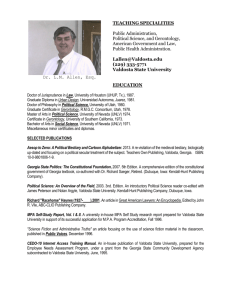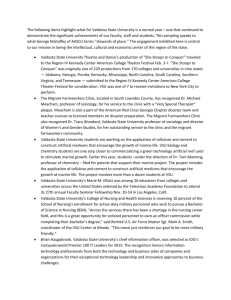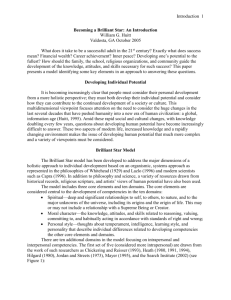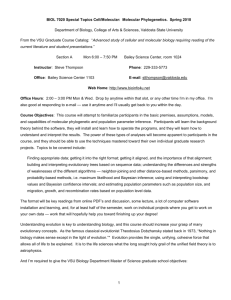PSYC 7020: Conditions of Learning
advertisement
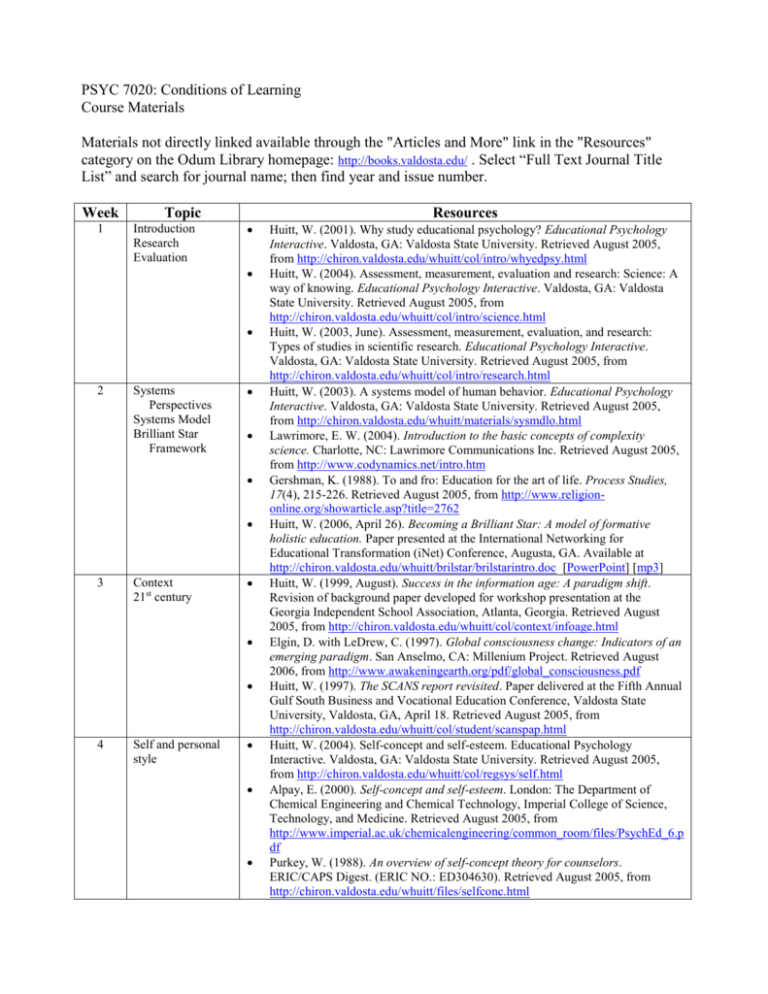
PSYC 7020: Conditions of Learning Course Materials Materials not directly linked available through the "Articles and More" link in the "Resources" category on the Odum Library homepage: http://books.valdosta.edu/ . Select “Full Text Journal Title List” and search for journal name; then find year and issue number. Week 1 Topic Introduction Research Evaluation Resources 2 Systems Perspectives Systems Model Brilliant Star Framework 3 Context 21st century 4 Self and personal style Huitt, W. (2001). Why study educational psychology? Educational Psychology Interactive. Valdosta, GA: Valdosta State University. Retrieved August 2005, from http://chiron.valdosta.edu/whuitt/col/intro/whyedpsy.html Huitt, W. (2004). Assessment, measurement, evaluation and research: Science: A way of knowing. Educational Psychology Interactive. Valdosta, GA: Valdosta State University. Retrieved August 2005, from http://chiron.valdosta.edu/whuitt/col/intro/science.html Huitt, W. (2003, June). Assessment, measurement, evaluation, and research: Types of studies in scientific research. Educational Psychology Interactive. Valdosta, GA: Valdosta State University. Retrieved August 2005, from http://chiron.valdosta.edu/whuitt/col/intro/research.html Huitt, W. (2003). A systems model of human behavior. Educational Psychology Interactive. Valdosta, GA: Valdosta State University. Retrieved August 2005, from http://chiron.valdosta.edu/whuitt/materials/sysmdlo.html Lawrimore, E. W. (2004). Introduction to the basic concepts of complexity science. Charlotte, NC: Lawrimore Communications Inc. Retrieved August 2005, from http://www.codynamics.net/intro.htm Gershman, K. (1988). To and fro: Education for the art of life. Process Studies, 17(4), 215-226. Retrieved August 2005, from http://www.religiononline.org/showarticle.asp?title=2762 Huitt, W. (2006, April 26). Becoming a Brilliant Star: A model of formative holistic education. Paper presented at the International Networking for Educational Transformation (iNet) Conference, Augusta, GA. Available at http://chiron.valdosta.edu/whuitt/brilstar/brilstarintro.doc [PowerPoint] [mp3] Huitt, W. (1999, August). Success in the information age: A paradigm shift. Revision of background paper developed for workshop presentation at the Georgia Independent School Association, Atlanta, Georgia. Retrieved August 2005, from http://chiron.valdosta.edu/whuitt/col/context/infoage.html Elgin, D. with LeDrew, C. (1997). Global consciousness change: Indicators of an emerging paradigm. San Anselmo, CA: Millenium Project. Retrieved August 2006, from http://www.awakeningearth.org/pdf/global_consciousness.pdf Huitt, W. (1997). The SCANS report revisited. Paper delivered at the Fifth Annual Gulf South Business and Vocational Education Conference, Valdosta State University, Valdosta, GA, April 18. Retrieved August 2005, from http://chiron.valdosta.edu/whuitt/col/student/scanspap.html Huitt, W. (2004). Self-concept and self-esteem. Educational Psychology Interactive. Valdosta, GA: Valdosta State University. Retrieved August 2005, from http://chiron.valdosta.edu/whuitt/col/regsys/self.html Alpay, E. (2000). Self-concept and self-esteem. London: The Department of Chemical Engineering and Chemical Technology, Imperial College of Science, Technology, and Medicine. Retrieved August 2005, from http://www.imperial.ac.uk/chemicalengineering/common_room/files/PsychEd_6.p df Purkey, W. (1988). An overview of self-concept theory for counselors. ERIC/CAPS Digest. (ERIC NO.: ED304630). Retrieved August 2005, from http://chiron.valdosta.edu/whuitt/files/selfconc.html 5 Brain Psychomotor 6 Paradigms in Instruction Behavioral 7 Perceptual processing Cognitive – Information Processing 8 Affect and Emotions Values in Action: Inventory of Strengths: from Positive Psychology (Martin Seligman)-- http://www.viastrengths.org/ Learning style online -- http://www.learning-styles-online.com/ Index of Learning Styles Questionnaire -http://www.engr.ncsu.edu/learningstyles/ilsweb.html Jung Typology Test -- http://www.humanmetrics.com/cgi-win/JTypes2.asp DISC Profiler -- http://www.personalityinsights.com/ Learning Styles: A Multiple Intelligences Approach -http://pss.uvm.edu/pss162/learning_styles.html. VARK: Guide to learning styles -- http://www.vark-learn.com/english/index.asp Duboc, B. (2006). The brain from top to bottom: From the simple to the complex. Ottawa, Canada: Canadian Institutes of Health Research. Retrieved May 2006, from http://www.thebrain.mcgill.ca/flash/index_d.html Geary, D. & Bjorklund, D. (2000). Evolutionary developmental psychology. Child Development, 71(1), 57-65. Caldwell, M., & Huitt, W. (2004). An overview of physical development. Educational Psychology Interactive. Valdosta, GA. Retrieved August 2005, from http://chiron.valdosta.edu/whuitt/brilstar/chapters/physdevelop.doc Raman, S. P., & Bowen, E. (1975). Nutrition and development. The Constructive Triangle, II(2), 41-46. Retrieved August 2005, from http://teach.valdosta.edu/anisa/constructive/raman.pdf Bryan, J., Osendarp, S., Hughes, D., Calvaresi, E., Baghurst, K., & van Klinken, J-W. (2004). Nutrients for cognitive development in school-aged children. Nutrition Reviews, 62(8), 295-306. Retrieved September 2006, from http://www.findarticles.com/p/articles/mi_qa3624/is_200408/ai_n9454695/print Koschmann, T. (2001). Revisiting the paradigms of instructional technology. Meeting at the Crossroads. In G. Kennedy, M. Keppell, C. McNaught & T. Petrovic (Eds.), Meeting at the Crossroads. Proceedings of the 18th Annual Conference of the Australian Society for Computers in Learning in Tertiary Education. (pp. 15 - 22). Melbourne: Biomedical Multimedia Unit, The University of Melbourne.Retrieved May 2006, from http://www.ascilite.org.au/conferences/melbourne01/pdf/papers/koschmannt.pdf Graham, G. (2002). Behaviorism. In E. Zalta (Ed.), The Stanford Encyclopedia of Philosophy. Retrieved August 2005, from http://plato.stanford.edu/entries/behaviorism Huitt, W., & Hummel, J. (1997). An introduction to operant (instrumental) conditioning. Educational Psychology Interactive. Valdosta, GA: Valdosta State University. Retrieved August 2005, from http://chiron.valdosta.edu/whuitt/col/behsys/operant.html Runeson, S., & Anderson, I. (2004). On two modes of apprehension. Ecological Psychology, 16(1), 37-44. Lutz, S., & Huitt, W. (2003). Information processing and memory: Theory and applications. Educational Psychology Interactive. Valdosta, GA. Retrieved August 2005, from http://chiron.valdosta.edu/whuitt/brilstar/chapters/infoproc.doc Beer, R. (2000). Dynamical approaches to cognitive science. Trends in Cognitive Sciences, 4(3), 91-99. Retrieved August 2005, from http://vorlon.cwru.edu/~beer/Papers/TICS.pdf Brett, A., Smith, M., Price, E., & Huitt, W. (2003). The affective domain. Educational Psychology Interactive. Valdosta, GA: Valdosta State University. Retrieved August 2005, from http://chiron.valdosta.edu/whuitt/brilstar/chapters/affectdev.doc Huitt, W. (1997). Socioemotional development. Educational Psychology Interactive. Valdosta, GA: Valdosta State University. Retrieved August 2005, from http://chiron.valdosta.edu/whuitt/col/affsys/erikson.html Lewis, M., Lamey, A., & Douglas, L. (1999). A new dynamic systems method for the analysis of early socioemotional development. Developmental Science, 2(4), 9 Cognitive – Constructivism Social – Constructivism 10 Social Constructivism (continued) Conation, volition, and selfregulation 11 Motivation Summary of learning and developmental theories 12 Spirituality Consciousness 13 Character Development 457-475. Huitt, W. (2001). Humanism and open education. Educational Psychology Interactive. Valdosta, GA: Valdosta State University. Retrieved August 2005, from http://chiron.valdosta.edu/whuitt/col/affsys/humed.html Lutz, S., & Huitt, W. (2004). Connecting cognitive development and constructivism: Implications from theory for instruction and assessment. Constructivism in the Human Sciences,9(1), 67-90. Retrieved August 2005, from http://chiron.valdosta.edu/whuitt/brilstar/chapters/cogdev.doc Riffert, F. (1999). Towards a process-psychology: Convergencies between Whitehead and Piaget. Salzburger Beiträge zur Erziehungswissenschaft 2(2), 5779. Retrieved August 2005, from http://www.sbg.ac.at/erz/salzburger_beitraege/fruehling99/fr_1999_1.pdf Alpay, E. (2003). The contribution of Vygotsky's theory to the contribution of our understanding of the relation between the social world and cognitive development. London: Imperial College. Retrieved August 2005, from http://www.ce.ic.ac.uk/common-room/files/PsychEd_5.pdf Ferdig, M. (2000). Complexity theories: Perspectives for the social construction of organizational transformation. Paper presented at the annual conference of the Midwest Academy of Management. Retrieved August 2005, from http://www.sba.muohio.edu/management/mwAcademy/2000/21d.pdf Huitt, W. (2004). Observational (social) learning: An overview. Educational Psychology Interactive. Valdosta, GA: Valdosta State University. Retrieved August 2005, from http://chiron.valdosta.edu/whuitt/col/soccog/soclrn.html Bandura, A. (2001). Social cognitive theory: An agentic perspective. Annual Review of Psychology, 52, 1-26. Retrieved August 2006, from http://www.des.emory.edu/mfp/Bandura2001ARPr.pdf Huitt, W., & Cain, S. (2005). An overview of the conative domain. Educational Psychology Interactive. Valdosta, GA: Valdosta State University. Retrieved August 2005, from http://chiron.valdosta.edu/whuitt/brilstar/chapters/conative.doc Karoly, P. (1993). Mechanisms of self-regulation: A systems view. Annual Review of Psychology, 44, 23-52. Huitt, W. (2001). Motivation to learn: An overview. Educational Psychology Interactive. Valdosta, GA: Valdosta State University. Retrieved August 2005, from http://chiron.valdosta.edu/whuitt/col/motivation/motivate.html Eccles, J., & Wigfield, A. (2002). Motivational beliefs, values, and goals. Annual Review of Psychology, 53, 109-132. Huitt, W. (2005, January). Summary of theories relating to learning and development. Educational Psychology Interactive. Valdosta, GA: Valdosta State University. Retrieved [date], from http://chiron.valdosta.edu/whuitt/col/summary/lrndev.html Huitt, W., & Robbins, J. (In press). An introduction to spiritual development. Constructivism in the Human Sciences. Retrieved August 2005, from http://chiron.valdosta.edu/whuitt/brilstar/chapters/spirituality.doc Mustakova-Possardt, E. (2004). Education for critical moral consciousness. Journal of Moral Education, 33(3), Retrieved August 2005, from http://chiron.valdosta.edu/whuitt/files/JME_criticalcons.pdf Vessels, G., & Huitt, W. (2005). Moral and character development. Paper presented at the Retrieved August 2005, from http://chiron.valdosta.edu/whuitt/brilstar/chapters/chardev.doc Bai, H. (2003). On the edge of chaos: Complexity and ethics. Proceedings of the 2003 Complexity Science and Educational Research Conference, Edmonton, Canada, October 16-18. Retrieved August 2005, from http://www.complexityandeducation.ualberta.ca/Documents/CSERProceedingsPD FsPPTs/CSER_Bai.pdf. 14 Model of Teaching/ Learning 15 School and Classroom Practice Last revised: August 2006 Huitt, W. (2003). A transactional model of the teaching/learning process. Educational Psychology Interactive. Valdosta, GA: Valdosta State University. Retrieved August 2005 from http://chiron.valdosta.edu/whuitt/materials/tchlrnmd.html. Huitt, W. (2005, April). Academic learning time. Educational Psychology Interactive. Valdosta, GA: Valdosta State University. Retrieved [date], from http://chiron.valdosta.edu/whuitt/col/process/ALT.html Huitt, W. (1999). Implementing effective school achievement reform: Four principles. Paper presented at the School Counseling Summit, Valdosta State University, Valdosta, GA, Retrieved August 2005, from http://chiron.valdosta.edu/whuitt/files/school_reform.html Fan, M. (2004). The idea of integrated education: From the point of view of Whitehead’s philosophy of education. Paper presented at the Forum for Integrated Education and Educational Reform sponsored by the Council for Global Integrative Education, Santa Cruz, CA, October 28-30. Retrieved August 2005, from http://chiron.valdosta.edu/whuitt/CGIE/fan.pdf. Huitt, W. (2006, April 25). Educational accountability in an era of global decentralization. Paper presented at the International Networking for Educational Transformation (iNet) Conference, Augusta, GA. Available at http://chiron.valdosta.edu/whuitt/papers/edaccount.doc [PowerPoint] [mp3-Part1] [mp3-Part2] Huitt, W. (2003). Models of teaching and instruction. Educational Psychology Interactive. Valdosta, GA: Valdosta State University. Retrieved August 2005, from http://chiron.valdosta.edu/whuitt/col/instruct/instmdls.html Dillon, J. T. (1997). Using diverse styles of teaching. Journal of Curriculum Studies, 30(5), 503-514. Retrieved August 2005, from http://faculty.ed.uiuc.edu/westbury/JCS/VOL30/dillon.html Huitt, W., Moneti, D., & Hummel, J. (in process). Designing direct instruction. In C. Reigeluth and A. Carr-Chellman (Eds.), Instructional-Design Theories and Models: Volume III, Building a Common Knowledgebase. Mahwah, NJ: Lawrence Erlbaum Associates. Cummings, C. (2000). Seeking self-discipline (Chapter 1). Winning strategies for classroom management. Alexandria, VA: Association for Supervision and Curriculum Development. Retrieved August 2005, from http://www.ascd.org/ed_topics/2000cummings/chapter1.html McMillan, J. (2000). Fundamental assessment principles for teachers and school administrators. Practical Assessment, Research & Evaluation, 7(8). Retrieved May 2001, from http://pareonline.net/getvn.asp?v=7&n=8 Sherburne, D. (1991). The process perspective as context for educational evaluation. Process Studies, 20(2), 78-85. Retrieved August 2005, from http://www.religion-online.org/showarticle.asp?title=2823
